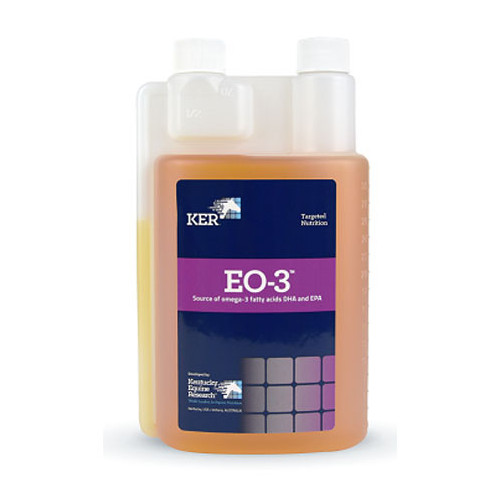The equine athlete that is provided EO-3 can benefit from the difference in inflammatory response. In addition, EO-3 has also demonstrated benefits to the cardiovascular system, reproductive performance, and bone development in numerous research studies in a variety of animal species. The consumption of EPA and DHA from a source such as EO-3 is the only way to ensure that these fatty acids are available for metabolism of the “less-inflammatory” compounds and other metabolites beneficial for the horse’s overall health and well-being.
EO-3 supplies omega-3 fatty acids, compounds with positive effects on reproduction, bone development and numerous inflammatory conditions in horses.
Why Choose EO-3?
- Palatable highly refined and flavoured marine-derived oil
- Improves glucose tolerance
- Strengthens immune function
- Increases red blood cell flexibility
- Enhances bone metabolism and development
- Benefits of DHA- and EPA-mediated inflammatory response include reduction in joint inflammation, allergic reactivity, exercise-induced bronchoconstriction, and exercise-induced pulmonary hemorrhage
- Reproductive benefits include improved fertility, improved colostrum quality, enhanced passive transfer of antibodies to foals, and increased sperm concentration, motility, and viability
- Marine-derived long-chain fatty acids DHA and EPA are more efficiently used as precursors of local hormones than plant-based sources of omega-3 fatty acids
- ACVIM consensus statement recommends DHA and EPA supplementation for horses with inflammatory airway disease/equine asthma
- Shown in studies to reduce GGT and inflammatory markers in exercising horses
RESEARCH PROVEN
Daily intake of EPA and DHA from KER EO-3™ significantly increases red blood cell membrane EPA and DHA, but a similar amount of omega-3 in the form of ALA from flax (linseed) oil does not.
Researchers have focused their attention on two distinct families of longchain polyunsaturated fatty acids (PUFA): the omega-3 family and the omega-6 family. The omega-3 family stems from alpha-linolenic acid (ALA), and the omega-6 family originates from linoleic acid (LA). The term omega-3 is in reference to the location of the first double bond positioned three carbon atoms from the terminal end of the fatty acid chain. Marine-derived oils are rich in the longer chain omega-3 fatty acids eicosapentaenoic acid (EPA) and docosahexaenoic acid (DHA), 20 and 22 carbon atoms, respectively, while ALA, containing 18 carbon atoms, can be found in plant sources such as flax, soybean, and canola. ALA and LA are considered “essential fatty acids”because they are instrumental in the life cycle, yet they cannot be manufactured in the body and must be obtained from dietary sources.
Omega-3 Fatty Acids
Significant members of the omega-3 family are EPA, DHA, and ALA. EPA and DHA are found almost exclusively in fish, namely cold-water species, since they are at the top of a food chain based largely on algae that manufacture EPA and DHA. On the other hand, ALA is found predominantly in leafy plants and flaxseed (linseed).
Average Rating
Write a Review
Write a Review
- Kentucky Equine Research
- Skin & Condition
- 946ml







